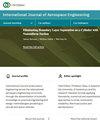Distributed Formation Control with Obstacle and Collision Avoidance for Hypersonic Gliding Vehicles Subject to Multiple Constraints
IF 1.2
4区 工程技术
Q3 ENGINEERING, AEROSPACE
引用次数: 0
Abstract
Multiple hypersonic gliding vehicles’ (HGVs’) formation control problems with obstacle and collision avoidance are investigated in this paper, which is addressed in the stage of entry gliding. The originality of this paper stems from the formation control algorithm where constraints of dynamic pressure, heating rate, total aerodynamic load, control inputs, collision avoidance, obstacle avoidance, and the terminal states are considered simultaneously. The algorithm implements a control framework designed to be of two terms: distributed virtual controller and actual control input solver. The distributed virtual controller is based on distributed model predictive control with synchronous update strategy, where the virtual control signals are derived by the optimization simultaneously at each time step for each HGV under directed communication topology. Subsequently, according to the virtual control signals obtained, a coupled nonlinear equation set is solved to get actual control signals: each HGV’s bank angle together with the angle of attack. The actual control input solver adopts a feasible solution process to calculate the actual control signals while dealing with constraints. Finally, extensive numerical simulations are implemented to unveil the proposed algorithm’s performance and superiority.高超音速滑翔飞行器的分布式编队控制与障碍物和碰撞规避
本文研究了多个高超音速滑翔飞行器(HGVs)的编队控制问题,其中包括避障和避撞问题,该问题是在进入滑翔阶段解决的。本文的独创性源于编队控制算法,其中同时考虑了动压、加热率、总气动负荷、控制输入、避碰、避障和终端状态等约束条件。该算法实现的控制框架设计为两部分:分布式虚拟控制器和实际控制输入求解器。分布式虚拟控制器基于同步更新策略的分布式模型预测控制,在定向通信拓扑结构下,每辆重型车辆的虚拟控制信号都是在每个时间步同时通过优化得到的。随后,根据得到的虚拟控制信号,求解耦合非线性方程组,得到实际控制信号:每辆 HGV 的倾角和攻角。实际控制输入求解器采用可行的求解过程来计算实际控制信号,同时处理各种约束条件。最后,通过大量的数值模拟,揭示了所提出算法的性能和优越性。
本文章由计算机程序翻译,如有差异,请以英文原文为准。
求助全文
约1分钟内获得全文
求助全文
来源期刊

International Journal of Aerospace Engineering
ENGINEERING, AEROSPACE-
CiteScore
2.70
自引率
7.10%
发文量
195
审稿时长
22 weeks
期刊介绍:
International Journal of Aerospace Engineering aims to serve the international aerospace engineering community through dissemination of scientific knowledge on practical engineering and design methodologies pertaining to aircraft and space vehicles.
Original unpublished manuscripts are solicited on all areas of aerospace engineering including but not limited to:
-Mechanics of materials and structures-
Aerodynamics and fluid mechanics-
Dynamics and control-
Aeroacoustics-
Aeroelasticity-
Propulsion and combustion-
Avionics and systems-
Flight simulation and mechanics-
Unmanned air vehicles (UAVs).
Review articles on any of the above topics are also welcome.
 求助内容:
求助内容: 应助结果提醒方式:
应助结果提醒方式:


